Ancient jewelry makers developed sophisticated alloy recipes combining gold, silver, and copper in precise ratios. You’ll find that Egyptians created 22-karat gold with 91.67% purity, while Greeks favored “white gold” with 60% gold and 40% silver. Romans mastered red gold using 750 parts gold to 250 parts copper, and sterling silver emerged with 92.5% silver and 7.5% copper. These civilizations also experimented with arsenic-copper alloys and complex niello formulations that established the foundation for modern metalworking techniques.
Gold and Electrum Compositions in Ancient Civilizations
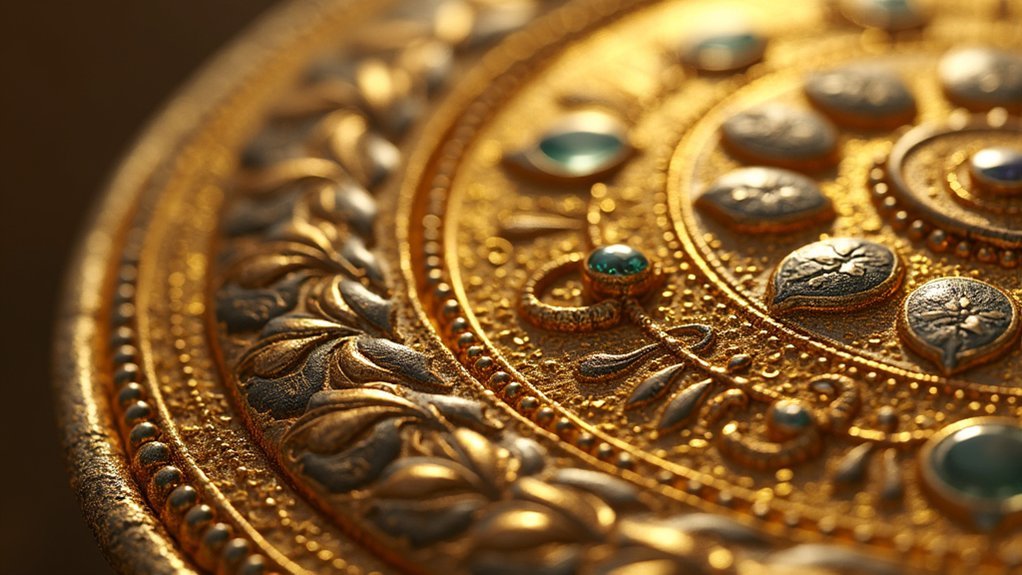
While modern jewelers rely on standardized alloy formulations, ancient civilizations developed their precious metal recipes through centuries of experimentation and regional resource availability.
You’ll find that electrum, a naturally occurring alloy of gold and silver, became their foundation for jewelry making. This alloy’s composition varied dramatically, ranging from 20% to 80% gold content, which you can see reflected in the diverse hues and properties of surviving ancient pieces.
Egyptian craftsmen mastered the art of creating deliberate gold alloys by incorporating copper and silver, most commonly producing 22-karat gold with 91.67% purity.
Egyptian artisans perfected deliberate gold alloy techniques, skillfully blending copper and silver to achieve their signature 22-karat gold standard.
Meanwhile, you’d discover that ancient Greek jewelers favored their “white gold” recipe containing 60% gold and 40% silver, achieving lighter coloration while preserving gold’s desirable characteristics.
Silver-Based Alloys and Their Archaeological Evidence
Though silver naturally occurs in nearly pure form, ancient craftsmen discovered they could dramatically improve its workability and durability by adding copper to create stronger alloys.
Archaeological excavations at Ur reveal silver artifacts containing varying copper percentages, demonstrating this widespread practice dating to the 3rd millennium BC.
You’ll find that ancient jewelers experimented extensively with silver and copper combinations. Sterling silver, containing 92.5% silver and 7.5% copper, became a preferred standard that balanced luster with strength.
Egyptian and Roman artifacts also show silver-lead alloys were common during those periods.
Craftsmen didn’t stop there—they added tin to some pieces, creating unique aesthetic and functional properties.
These archaeological findings prove ancient metalworkers systematically developed sophisticated alloying techniques to enhance their jewelry’s performance and appearance.
Copper and Bronze Formulations for Decorative Elements
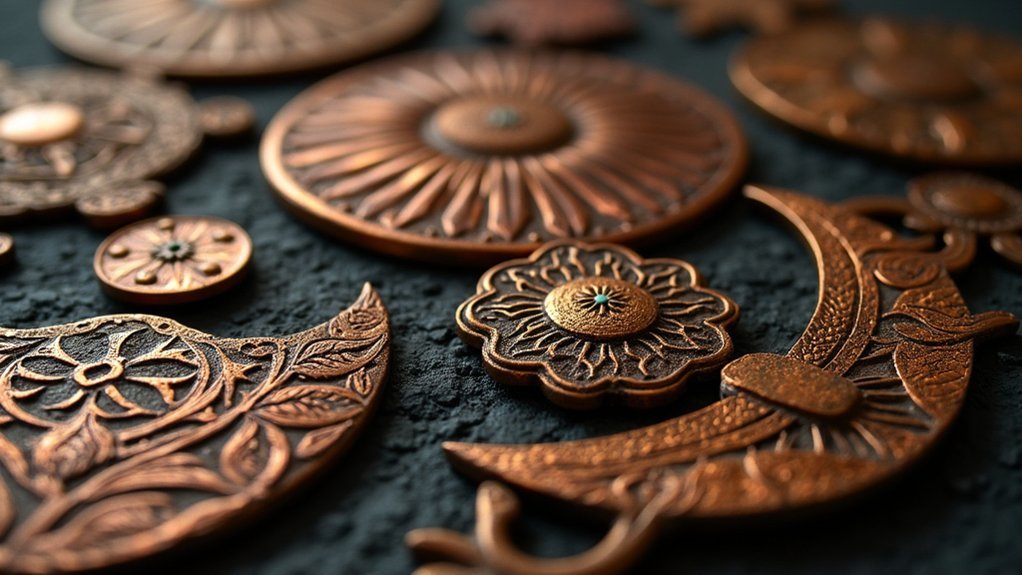
You’ll find that ancient Egyptian artisans mastered copper manipulation techniques that laid the groundwork for sophisticated alloy development in decorative jewelry.
Their early work with arsenic-enhanced copper, containing 3-4% arsenic for improved hardness and casting fluidity, eventually evolved into more refined tin-bronze formulations.
This change from arsenic-rich alloys to tin-based bronze represents an essential technological shift that you can trace across multiple ancient civilizations through surviving jewelry artifacts.
Ancient Egyptian Copper Techniques
When examining ancient Egyptian copper techniques, you’ll discover that metalworkers deliberately manipulated alloy compositions to achieve specific properties for their decorative jewelry elements.
You’ll find they initially added arsenic to enhance hardness and improve casting fluidity, creating superior copper alloys for intricate designs. As techniques evolved, you’ll notice the shift to tin-based formulations, with early Dynastic artifacts containing tin levels exceeding 1%.
You’ll observe that regional variations emerged due to local traditions and available metal deposits’ geochemistry.
Egyptian craftsmen developed sophisticated smelting methods, progressing from basic oxide ore processing to advanced tapped-slag furnaces in the Sinai region during the New Kingdom.
These copper alloys weren’t merely functional—they symbolized social status, with metal purity directly reflecting the wearer’s wealth and position.
Arsenic-Tin Bronze Evolution
Building on these foundational copper techniques, Egyptian metalworkers advanced their craft by incorporating arsenic alongside tin to create sophisticated bronze alloys for decorative jewelry. You’ll find that arsenic-tin bronze represented a significant metallurgical breakthrough, enhancing both hardness and casting fluidity for intricate ornamental designs.
| Element | Percentage | Properties Enhanced | Period | Applications |
|---|---|---|---|---|
| Arsenic | 5%+ | Hardness, workability | Old Kingdom | Early decorative pieces |
| Tin | Variable | Durability, strength | 3000 BCE+ | Advanced jewelry |
| Copper | Base metal | Foundation material | All periods | Primary component |
| Arsenic-Tin | Combined | ideal casting | Later periods | Complex ornaments |
| Regional Mix | Varied | Local preferences | Throughout | Cultural artifacts |
You’ll notice this evolution from arsenic to tin reflected broader technological changes, as craftsmen discovered tin’s superior properties through expanding trade networks.
Regional Variations in Ancient Alloying Techniques
You’ll find that Egyptian copper mining methods shaped their unique approach to creating arsenic-copper alloys, which they perfected during the Old Kingdom period for enhanced hardness and workability.
Mediterranean cultures developed distinct gold alloy traditions, with Greeks favoring naturally occurring electrum while other regions intentionally mixed gold and silver to achieve specific aesthetic and functional properties.
These regional preferences weren’t just practical choices—they reflected each civilization’s access to local resources and their evolving understanding of metallurgical principles.
Egyptian Copper Mining Methods
Three distinct mining regions shaped Egyptian copper production and influenced their sophisticated alloying techniques.
You’ll find that ancient Egyptians developed systematic prospecting methods using state expeditions and smaller specialized groups to identify mineral deposits across the Eastern Desert and Sinai Peninsula.
Their mining operations revealed remarkable engineering sophistication:
- Underground infrastructure – Cylindrical shafts connected by extensive galleries, as seen at Timna mines operating from the fourth millennium BC
- Processing efficiency – Ores were treated near extraction sites to reduce transport costs and enable accurate tallying
- Intentional alloying – High arsenic content in copper artifacts correlates with lower impurity levels, demonstrating deliberate metallurgical choices
You’d discover that variations in copper alloy compositions directly reflect local geochemistry, extraction techniques, and purposeful addition of elements like arsenic and tin to enhance material properties.
Mediterranean Gold Alloy Traditions
While Egyptian miners perfected copper extraction and alloying techniques in their desert regions, Mediterranean civilizations developed equally sophisticated traditions centered on gold alloy innovations.
You’ll find that ancient gold craftsmanship varied considerably across these cultures. Greeks prized electrum, a natural gold-silver mixture containing 20-80% silver that produced distinctive pale yellow hues.
Roman goldsmiths created diverse colored alloys by mixing gold with silver and copper, achieving red gold through 750 parts gold to 250 parts copper, and white gold by combining gold with silver.
The most common Mediterranean alloy was 22k gold at 91.67% purity, enhanced with silver and copper for improved strength.
During the Late Bronze Age, craftsmen began incorporating tin to improve casting properties and jewelry durability.
Metallurgical Analysis of Recovered Ancient Jewelry
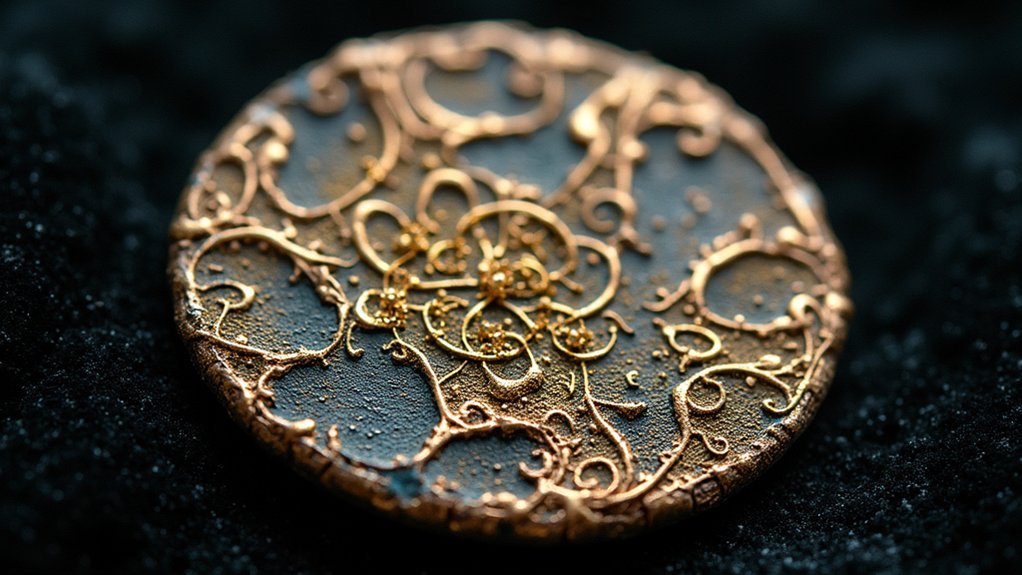
When archaeologists recover ancient jewelry from excavation sites, metallurgical analysis becomes the key to revealing secrets about past civilizations’ technological capabilities and cultural practices.
You’ll find that examining elemental composition identifies alloying elements and their proportions in recovered precious metal artifacts.
Ancient Egyptian jewelry demonstrates sophisticated copper alloy usage, with compositions varying based on local ores and production techniques.
You can distinguish between native and smelted copper through thorough analysis, while impurities indicate specific metallurgical methods from different historical periods.
- Arsenic and tin were intentionally added to enhance metal properties
- Regional variations reflect local traditions and material availability
- High-purity copper indicates advanced smelting techniques
The change from arsenic to tin in ancient copper alloys showcases evolving metallurgical practices across cultures and time periods.
Raw Material Sources and Mining Operations
Before ancient jewelers could craft their sophisticated alloys, they needed reliable access to raw materials through well-organized mining operations.
You’ll find evidence of Egyptian expertise in prospecting across the Eastern Desert and Sinai, where they used knowledge of land formations and flora to locate copper deposits. Workers like Thuthotep left graffiti documenting systematic gold prospecting efforts at major sites including Serabit el-Khadim and Timna.
You’d discover that ancient miners employed cylindrical shafts connected by underground galleries, revealing sophisticated extraction strategies.
They processed ores near mining sites for easier transport, considering economic factors and the melting point requirements for different metals. This proximity allowed efficient ore treatment and guaranteed quality raw materials reached craftsmen who’d create intricate jewelry alloys.
Evolution of Alloy Recipes Across Historical Periods
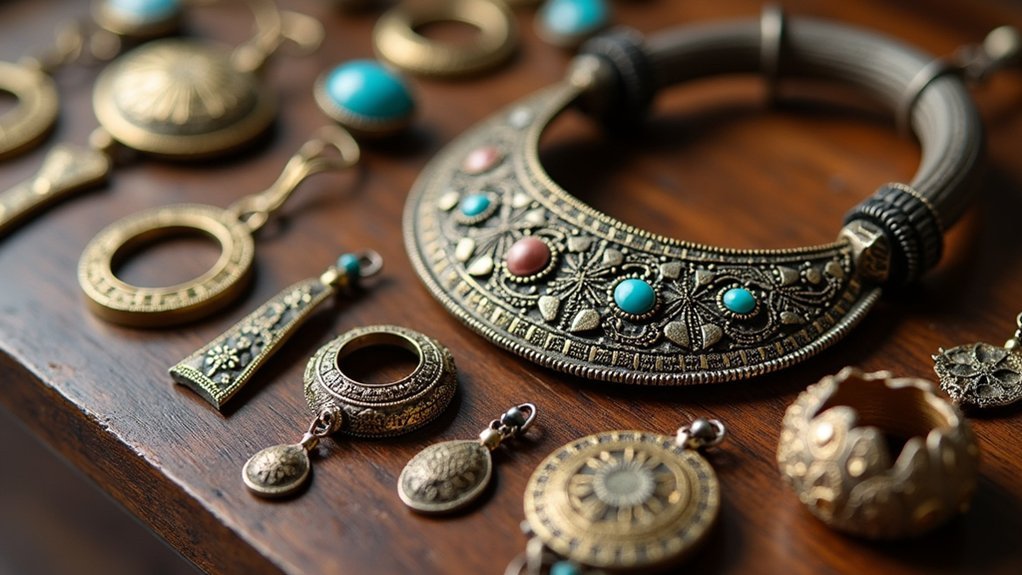
Once ancient civilizations secured their raw materials, they began experimenting with different combinations to create alloys that would transform jewelry making forever.
Ancient craftsmen’s innovative alloy experiments laid the groundwork for revolutionary advances that would forever change the art of jewelry creation.
You’ll find that Egyptian artisans mastered high-purity gold and silver blends, adding copper to achieve durability and stunning color variations like red gold (750 parts gold, 250 parts copper).
During the Bronze and Iron ages, metallurgical knowledge expanded dramatically:
- Old Kingdom innovations – Arsenic-copper alloys dominated, providing enhanced hardness for intricate designs
- New Kingdom developments – Tin replaced arsenic, marking sophisticated alloy evolution
- Decorative breakthroughs – Niello emerged as a complex black alloy combining silver, copper, lead, and sulfur
Historical goldsmithing emphasized 22k gold purity with fine silver, employing fusing and granulation techniques that created the foundation for modern jewelry craftsmanship.
Frequently Asked Questions
What Was Ancient Jewelry Made Of?
You’d find ancient jewelry crafted from high-purity gold and silver, often alloyed with copper for strength. Copper alloys with arsenic or tin were common, while native copper was used in earliest pieces before advanced smelting developed.
What Are the Alloys Used in Jewellery?
You’ll find gold alloys like 22k gold, red gold with copper, and white gold with silver dominating jewelry. Pinchbeck’s copper-zinc blend and tombac’s copper-tin-zinc mixture also create beautiful, durable pieces.
What Did Ancient Egyptians Use to Make Jewelry?
You’d find ancient Egyptians crafting jewelry from high-purity gold, copper, bronze, and unique copper-arsenic alloys. They’d incorporate silver, semi-precious stones, and enamel, using techniques like hammering, soldering, fusing, and granulation for elaborate designs.
What Are the Unusual Gold Alloys?
You’ll find unusual gold alloys like blue gold (gold-iron), red gold (gold-copper), green gold (gold-silver), plus historical substitutes including Pinchbeck (copper-zinc) and Tombac (copper-tin-zinc) that mimic gold’s appearance.
In Summary
You’ll discover that ancient jewelers weren’t just artists—they were sophisticated metallurgists who developed complex alloy recipes through centuries of experimentation. You can trace their evolution from simple gold-silver mixtures to intricate bronze formulations that varied dramatically by region and era. They’d carefully balance durability with beauty, creating pieces that’ve survived millennia. Today’s analysis reveals their remarkable understanding of metallurgy, proving ancient craftspeople possessed advanced technical knowledge we’re still uncovering.

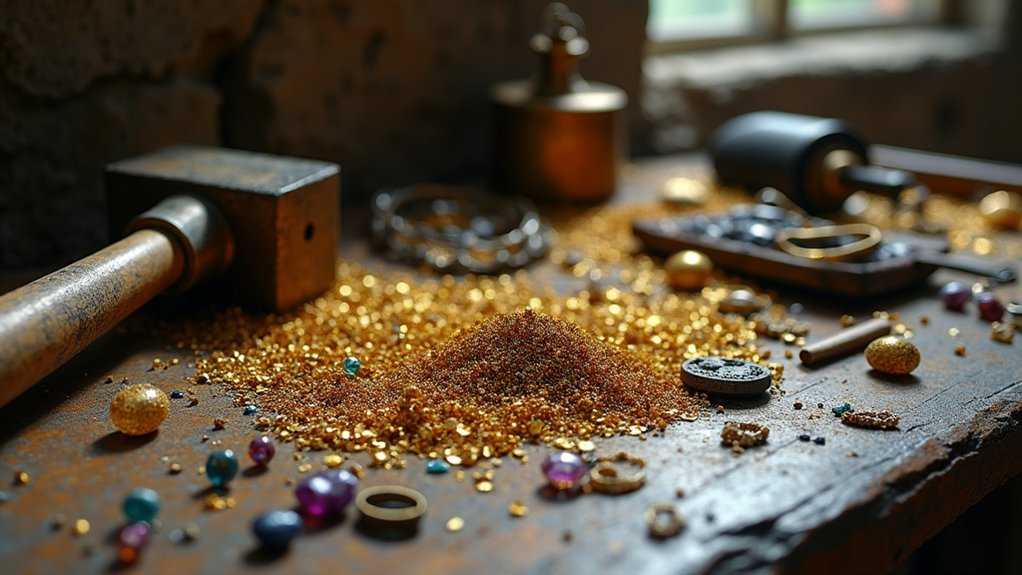



Leave a Reply